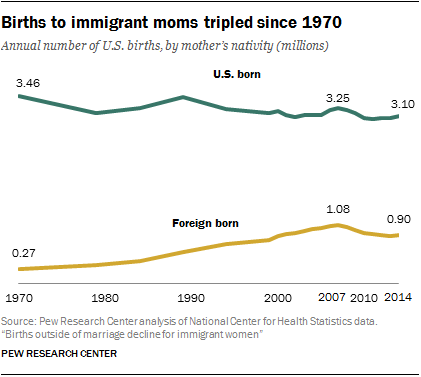 In 2014 more than 900,000 births in the U.S. were to foreign-born mothers. That marks a threefold increase from 1970, when 274,000 babies were born to immigrant mothers10 The trend in births to U.S.-born women has moved in the opposite direction – from 3.46 million births in 1970 to 3.10 million in 2014 (an 11% drop). As a result of these divergent trends, the increase in the overall number of U.S. births, from 3.74 million in 1970 to 4.0 million in 2014, is due entirely to births to foreign-born mothers.11
In 2014 more than 900,000 births in the U.S. were to foreign-born mothers. That marks a threefold increase from 1970, when 274,000 babies were born to immigrant mothers10 The trend in births to U.S.-born women has moved in the opposite direction – from 3.46 million births in 1970 to 3.10 million in 2014 (an 11% drop). As a result of these divergent trends, the increase in the overall number of U.S. births, from 3.74 million in 1970 to 4.0 million in 2014, is due entirely to births to foreign-born mothers.11
The annual number of births to all mothers – immigrant and native born – fell off substantially during and after the Great Recession. Birth declines among the foreign born were both more dramatic and more enduring than those of U.S.-born women. While the number of births to U.S.-born mothers began to inch back up as early as 2012, it wasn’t until 2014 that the number of babies born to foreign-born women ticked up.
Even given the birth declines associated with the Great Recession, by 2014, 23% of all babies born in the U.S. had immigrant mothers, up from just 7% in 1970. This long-term rise in the share of births to foreign-born women is partially – but not entirely – driven by growth in the overall U.S. immigrant population. In 1970, just 5% of the U.S. population was foreign born; by 2014, that share had grown considerably, to 14%.
One factor likely contributing to the disproportionate share of births to immigrant women is the age and sex structure of the population. In 2014, while 14% of the entire U.S. population was comprised of immigrants, fully 17% of childbearing-age women in the U.S. were foreign born.
 Nativity differences in the age and sex profile don’t explain all of the fertility differences between the foreign born and U.S. born. Even taking into consideration the growth in the share of immigrant women of childbearing age, it’s still the case that foreign-born women account for a disproportionately large share of births. This is due in part to the fact that foreign-born women in the U.S. have higher fertility than their U.S.-born counterparts. In 2014, the birth rate – children born per 1,000 women of childbearing age – stood at 84.2 for immigrant women. In comparison, the rate for U.S.-born women was 58.3. In other words, a foreign-born woman of childbearing age was about 44% more likely than her U.S.-born counterpart to have had a recent birth.12
Nativity differences in the age and sex profile don’t explain all of the fertility differences between the foreign born and U.S. born. Even taking into consideration the growth in the share of immigrant women of childbearing age, it’s still the case that foreign-born women account for a disproportionately large share of births. This is due in part to the fact that foreign-born women in the U.S. have higher fertility than their U.S.-born counterparts. In 2014, the birth rate – children born per 1,000 women of childbearing age – stood at 84.2 for immigrant women. In comparison, the rate for U.S.-born women was 58.3. In other words, a foreign-born woman of childbearing age was about 44% more likely than her U.S.-born counterpart to have had a recent birth.12
This has been a consistent pattern since at least 1970, when the modern wave of immigration, mainly from Latin America and Asia, was getting underway. The birth rate that year was 121.5 for immigrant women, while the rate for U.S.-born women was 86.5.
In 2006, just before the start of the recession, birth rates of foreign-born women were almost 70% higher than those of U.S.-born women (103.0 vs. 61.5). These differences have diminished somewhat since then, as immigrant birth rates have declined more rapidly than the birth rates of U.S.-born women in the wake of the Great Recession.
Though overall U.S. birth rates ticked up just prior to the recession, in the long term, they have declined noticeably. In 1970 the rate was 88.5 births per 1,000 women of childbearing age, and after hitting a historical low of 62.3 in 2013, rates inched up for the first time since the recession in 2014, to 62.8.13 The 2014 U.S. birth rate is about 29% lower than it was in 1970.14 For both the foreign born and U.S. born, long-term declines in fertility have been more dramatic – by 2014 the rate among the foreign born had dropped 31% since 1970 and among the U.S. born, there was a 33% decline.15
U.S. births to unauthorized immigrant parents
About 275,000 babies were born to unauthorized-immigrant parents in 2014, or about 7% of all births in the U.S. that year, according to new Pew Research Center estimates based on government data. This represented a decline from 330,000 in 2009, at the end of the Great Recession.
Births to unauthorized immigrants accounted for about one-in-three (32%) births to foreign-born mothers in 2014, according to the estimates.
The 2014 estimates of births to unauthorized immigrants are based on data from the Census Bureau’s American Community Survey, using the widely accepted residual methodology employed by Pew Research Center for many years. By comparison, the findings in this report about the number of U.S. births to foreign-born mothers are based on data from the National Center for Health Statistics. Both data sources produce very similar results in terms of the number of U.S. births to immigrant mothers and their share of all U.S. births.


